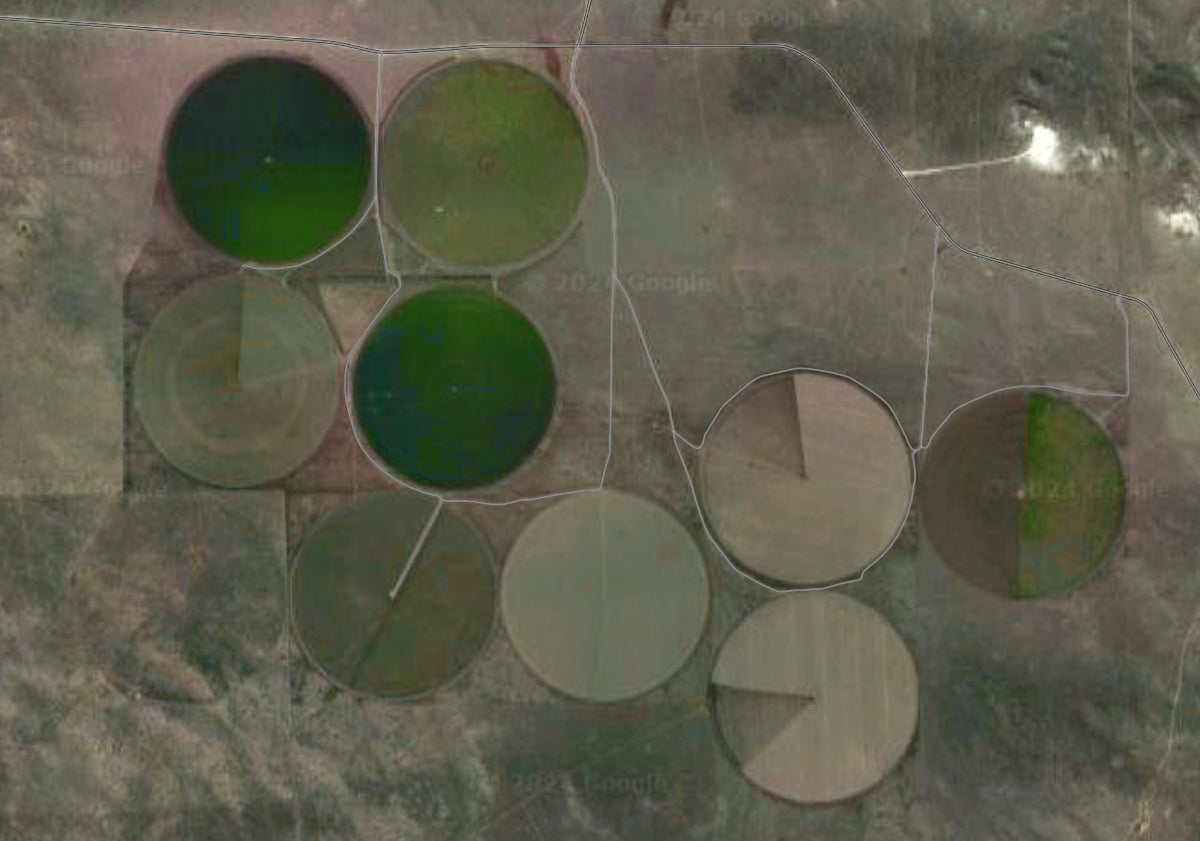If you’ve ever been bored on a long flight across America, you may have looked out your window and noticed clusters of perfect circles traced on the ground below. These are quite literally crop circles, though of the pedestrian, manmade variety, rather than those created by aliens. Each circle is the area covered by a massive irrigation apparatus called a center pivot, beneath which a farmer has planted corn or potatoes, alfalfa, or some other crop.
Center pivots are both simple and remarkably clever. Picture a long, gently arced metal truss raised high off the ground by poles with wheels at their base. Now picture a series of such trusses, all linked together. Sprinklers spaced along the entire length ensure even distribution of water. One end is fixed to a central point, around which the whole thing swings, hence the name. When seen over a field of corn, it looks like a bridge spanning a green sea.

To work, the motors in the wheels must be appropriately calibrated, since the end needs to move faster than than the middle, which needs to move faster than points closer to the center. A variety of sprinkler heads must be used to account for the variable pressure of the irrigation water and the variable speed of travel. If that doesn’t make sense, don’t worry. My point is that a lot of careful engineering and calibration by very smart people has gone into making center pivots the go-to tool for irrigating large acreage.
And I do mean large. A typical center pivot will irrigate 125 acres of land, meaning two pivots could more than cover my entire farm, if my farm was flat instead of hilly. They are efficient, in that they distribute water with minimal waste, and they are a proven and robust system, having been in use for over 70 years. But they have one glaring inefficiency, which you may have spotted. Most land, especially the sort of huge, flat stretches of land suitable for pivot irrigation, is divided into squares. Draw a circle within that square and the corners aren’t covered. To put a number on it, a circle drawn within a square will only cover 78% of the square’s total. Each center pivot leaves 20% of a field unirrigated.
What I find so interesting about this is that agriculture, especially the type of industrial agriculture that uses most center pivots, is an industry that operates on small margins. But the way pivots are designed means a farmer has to leave a bunch of land unplanted. If there was away to distribute water as well as a center pivot does and to evenly cover a field from corner to corner, farmers would use it. But technologies capable of full coverage either can’t distribute water as evenly as a center pivot or cost significantly more to set up and operate.
There’s a lesson here, one I’d encourage you to keep in mind whenever you read about a supposedly revolutionary breakthrough in the areas of farming and food: just because something is possible does not mean it is practical in the real world. Though some farmers opt for alternatives, most have stuck with reliable and functional center pivots in spite of their obvious, massive inefficiency. In seventy years, no one has developed a better alternative, despite the huge potential benefits of doing so.

Now think of vertical farming. Yes, it is possible to grow plants in a sterilized medium under artificial lights with perfectly controlled temperature and nutrition, and the growth of such plants will be more predictable than the same plants grown in a field outside. But the the complexity of the system means it only makes sense to grow the very highest value crops, namely salad greens and herbs. Even if the huge amounts of electricity used by vertical farms was free, it would never make sense to grow something like corn indoors.
Or take lab-grown meat. The technology capable of inducing cow cells to replicate in a bioreactor exists. But which sounds more plausible — that someone will figure out how to evenly and cost-effectively cover an entire field with water, or that someone will solve the dozens of technical hurdles that would need to be solved to cost effectively grow hamburger in a vat? The fact that no one has solved the former should give you pause about the feasibility of solving the latter.
I’m not saying innovation never happens. But an innovation that claims to completely reinvent a massive industry in which a lot of very smart people work should be viewed skeptically, especially when, as in the case of farming, the industry is material rather than digital. The laws of nature are stubborn, and there’s usually a cost to bending them.


3 comments
Flew from nash tn 2 denver what a beautiful photo from above circles squares
Thank you very much, Garth Brown, for the very informative article. I’ve wondered about those huge circular areas from the sky. Hopefully the farmers get to use the pretty high percentage of unwatered areas to very good use.
This type of business and/or technological processes re-engineering seems to be similar to other types of changes where the public-facing technologies appear to be great but to the poor detriment of workers behind the scenes.
That 22% unwatered area could possibly be repurposed to be a kind of pollinator corridor and biodiversity store house.